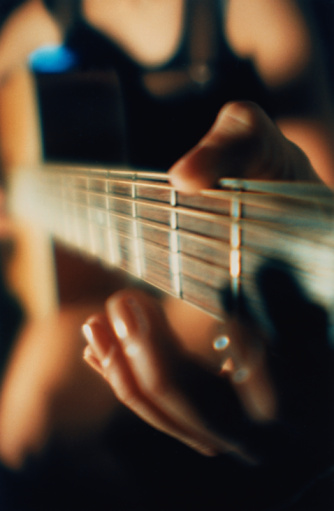by Jamey Andreas
Question 1: Thumb Position
I like to play in a similar style to Stefan Grossman and so my left thumb is frequently held on top of the neck waiting to fret the 6th or 5th string. This cradling of the neck style seems to cause a lot of tension, particularly in the first finger. Any thoughts on this?
Answer: First of all, the form for the left hand is not the same for all styles. For instance, you MUST have the thumb wrapped around the neck to bend properly. Some players prefer it also for getting certain chords (bass notes). The neck of an electric of course is also very different, and allows for the kind of form you are talking about.
Also, realize that there is no such thing as one best form, (in the sense of “do it this way, and never another way) especially given all the different types of guitars, styles, and players. It is very dangerous in a sense to watch great players. Often they will play with bad form sometimes, but are only able to do so because they have mastered “good” form.
I will leave you with an excellent thought I came across the other day from “Psycho-Cybernetics” by Maxwell Maltz. As important as the physical aspect of form is, the mental aspect of awareness is even greater, and this quote shows how form can follow awareness:
Johnny Bulla, the well-known professional golfer, wrote an article several years ago in which he said that having a clear mental image of just where you wanted the ball to go and what you wanted it to do was more important than form in golf. Most of the pros, said Bulla, have one or more serious flaws in their form. Yet they manage to shoot good golf. It was Bulla’s theory that if you would picture the end result — “see” the ball going where you wanted it to go, and have the confidence to “know” that it was going to do what you wanted, your subconscious mind would take over and direct your muscles correctly. If your grip was wrong, and your stance not in the best form, your subconscious would still take care of that by directing your muscles to do whatever was necessary to compensate for the error in form.
Now, that says a lot! Practicing is knowing the correct thing to do, and making sure you do it. Furthermore, the correct thing to do must be “known” on a very deep level.
Question 2: Thumb Movement
Answer: First, there is no such thing as getting too technical. Observation, thought, analysis, and experimentation are what it’s all about. People sometimes get confused by their own thinking, but that is only because they are not thinking “correctly”, but that is a whole ‘nother subject!
It is important to understand that the thumb position while playing constantly changes in response to the position of the fingers. There is always a “best” place for your thumb in any situation, and you must find it. It will feel balanced in relation to the force of the fingers. Often, even without actually changing the position of the thumb, you can improve a passage by experimenting with changing the direction in which the thumb is applying it’s force, sometimes even a slight change makes a difference.
Question 3: Development of 4th Finger
Answer: Yes, it will be a setback in many areas of playing. In the old days, when most players just wanted to be like Jimi Hendrix, and master pentatonic, blues based playing, you could get away with not developing or using your pinky. In fact, I remember when I was just starting out, and had begun to get some classical training which was getting my pinky in shape. Other players would watch me and say, “oh, you must be classical” with awe in their voices. I was something special because I could make use of my pinky!
Well, it is still true that for just blues based lead playing, you can get by nicely without using the pinky. Most bends are done with the third finger. But you will be excluded from a lot of music you would very likely want to play. For instance, a band like Metallica writes guitar parts that require a fully developed left hand to play. I always train my students for full use of the left hand.
It should be noted that the pinky, being the weakest finger, is the most difficult finger to train properly. It is the most difficult finger to develop so that it is capable of independent action from its neighbor, the ring finger. But once it is, look out!
